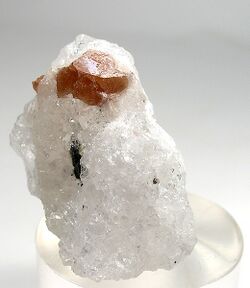Chemistry:Stillwellite-(Ce)
| Stillwellite-(Ce) | |
|---|---|
 1.3 cm stillwellite-(Ce) crystal in matrix | |
| General | |
| Category | Silicate mineral |
| Formula (repeating unit) | (Ce,La,Ca)BSiO 5 |
| Strunz classification | 9.AJ.25 |
| Dana classification | 54.02.03.02 |
| Crystal system | Trigonal |
| Crystal class | Pyramidal (3) H-M symbol: (3) |
| Space group | P31 |
| Identification | |
| Color | Red-brown to pale pink |
| Crystal habit | Flat rhombohedral crystals, massive |
| Twinning | Observed on {100} |
| Cleavage | Imperfect |
| Fracture | Conchoidal |
| Mohs scale hardness | 6.5 |
| |re|er}} | Resinous |
| Streak | White |
| Diaphaneity | Transparent to translucent |
| Specific gravity | 4.57–4.6 |
| Optical properties | Uniaxial (+) |
| Refractive index | nω = 1.765, nε = 1.780 |
| Birefringence | δ = 0.015 |
| Other characteristics | |
| References | [1][2][3] |
Stillwellite-(Ce) is a rare-earth boro-silicate mineral with chemical formula (Ce,La,Ca)BSiO
5.
Location
It occurs as a metasomatic replacement of metamorphosed limestones in the Mary Kathleen mine, Australia and in alkalic pegmatites associated with syenite in an alkaline massif in Tajikistan.[1] It occurs in association with allanite, garnet, uraninite in the Australian deposit; with calcite, monazite, bastnasite, thorite, uranothorite and thorianite in the Desmont mine, Wilberforce, Ontario, Canada ; and with pyrochlore, tienshanite, sogdianite, thorite, caesium kupletskite, reedmergnerite, steacyite, pectolite and quartz in the Tajikistan deposit.[1] It has also been reported from Mont Saint-Hilaire, Quebec, Canada and from Mineville, Essex County, New York. Other occurrences include the Inagli massif, Yakutia, Russia , around Langesundsfjord, Norway , in the Ilimaussaq intrusive complex, southern Greenland and the Vico volcano, Lazio, Italy.[1]
Discovery
It was first described in 1955 for an occurrence at the type locality is the Mary Kathleen Mine, 55 km (34 mi) east of Mount Isa, Queensland, Australia . It was named for Austrian mineralogist Frank Leslie Stillwell (1888–1963).[2][3]
Chemistry Breakdown
| (1) | (2) | (1) | (2) | |||
|---|---|---|---|---|---|---|
SiO2 |
22.40 | 22.06 | La2O3 | 27.95 | 19.12 | |
| UO2 | 0.22 | Ce2O3 | 33.15 | 30.82 | ||
| ThO2 | 5.41 | Pr2O3 | 1.82 | |||
| B2O3 | 12.23 | [13.46] | Nd2O3 | 5.36 | ||
| Al2O3 | 0.42 | Sm2O3 | 0.34 | |||
| Y2O3 | 0.74 | 0.28 | Fe2O3 | 0.18 |
References
- ↑ 1.0 1.1 1.2 1.3 http://rruff.geo.arizona.edu/doclib/hom/stillwellitece.pdf Handbook of Mineralogy
- ↑ 2.0 2.1 http://webmineral.com/data/Stillwellite-(Ce).shtml Webmineral data
- ↑ 3.0 3.1 http://www.mindat.org/min-3788.html Mindat.org
- ↑ Warr, L.N. (2021). "IMA–CNMNC approved mineral symbols". Mineralogical Magazine 85 (3): 291–320. doi:10.1180/mgm.2021.43. Bibcode: 2021MinM...85..291W.
 |

